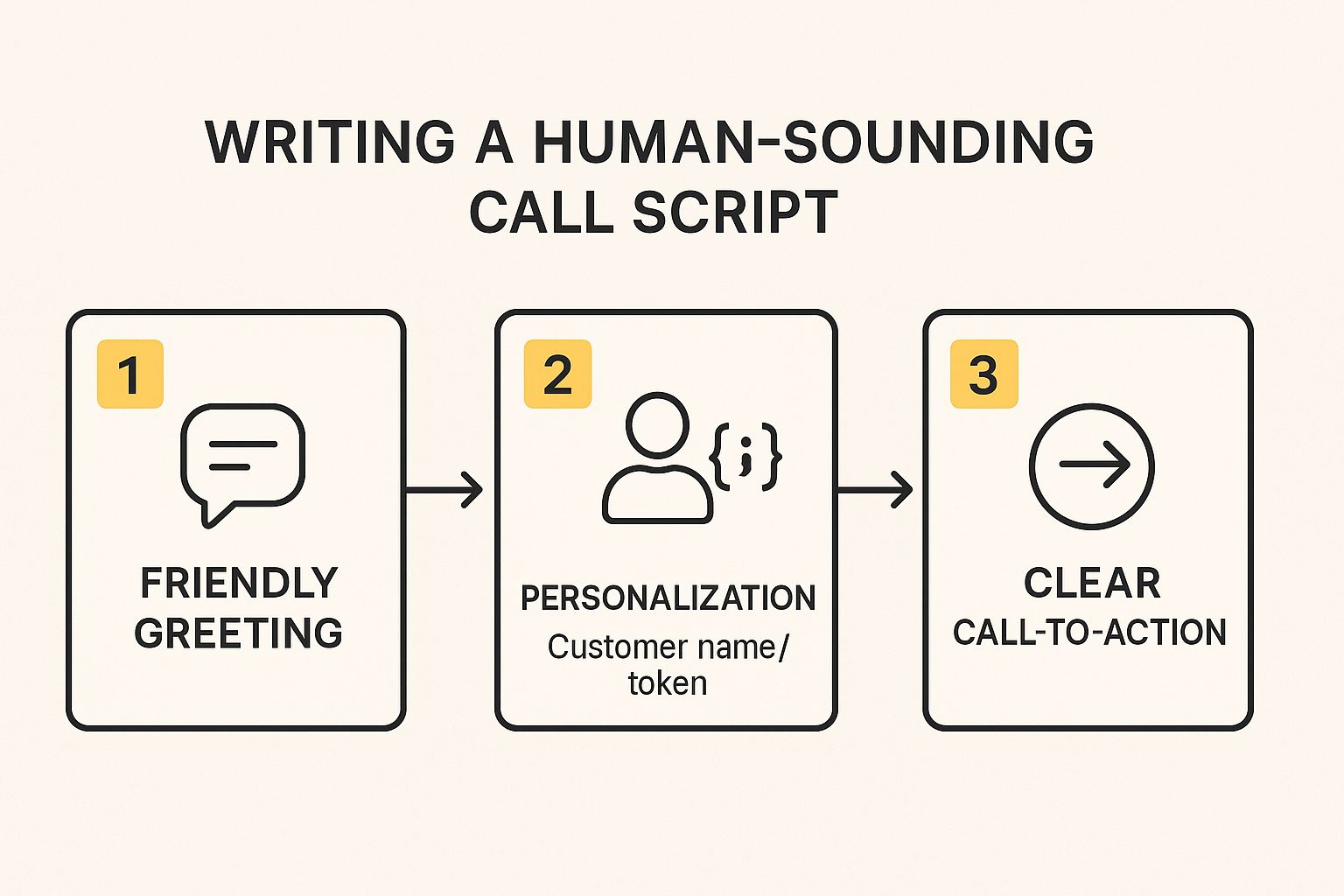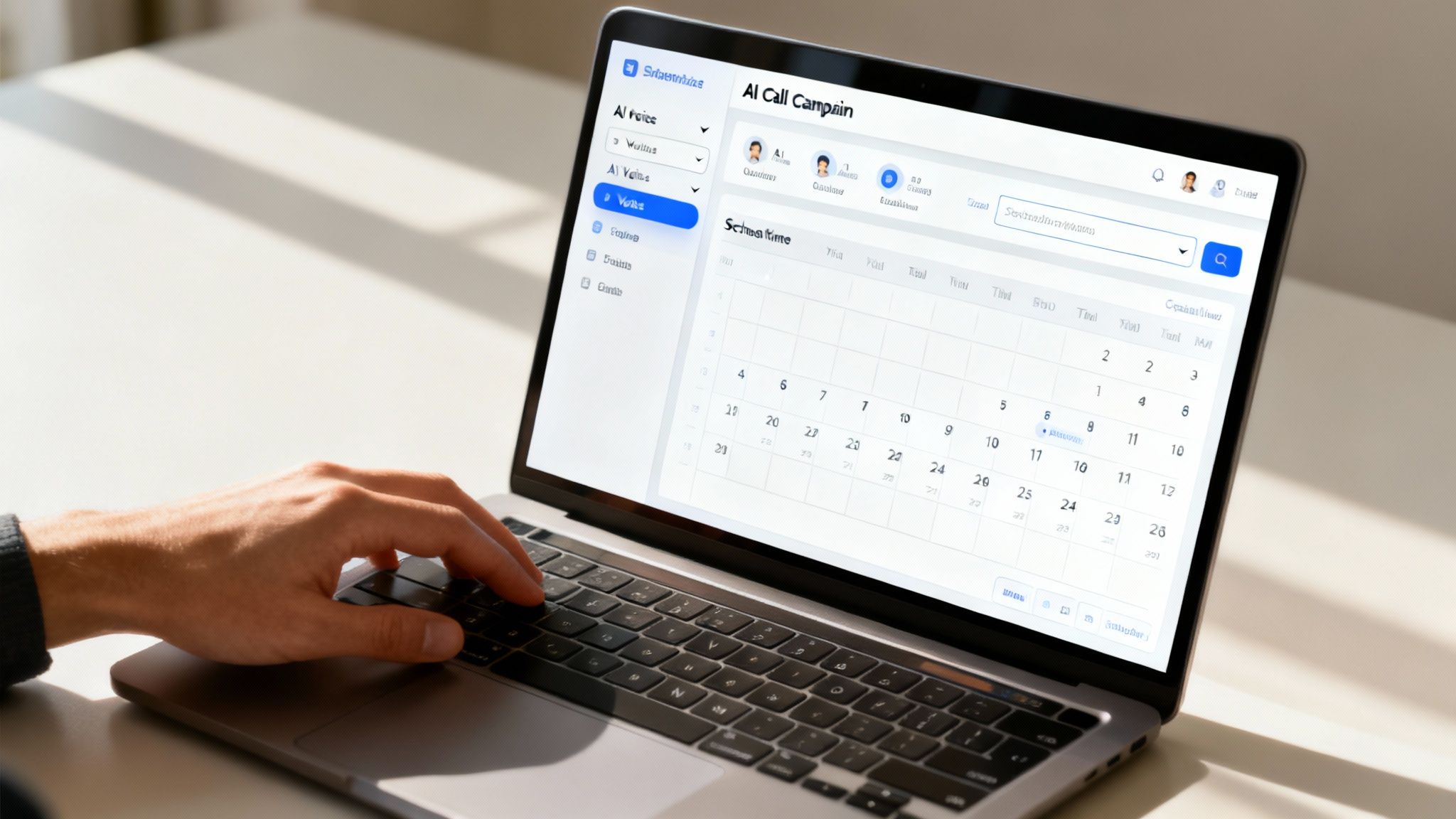To get started with automated phone calls, you'll need the right software to handle the dialling, play your messages, and track all the responses. The whole process boils down to defining your goal, pulling together a contact list, writing a solid script, and then setting up the campaign in an AI-powered system like OnSilent's AI Call Assistant.
But here's the thing: it's less about the tech itself and more about crafting a smart, human-focused strategy.
Why Automated Calls Are a Modern Business Tool

First, let's ditch the outdated idea of those annoying, disruptive robocalls. These days, learning how to make automated phone calls is all about adopting a powerful tool for genuine business growth. Companies are moving away from generic, one-size-fits-all blasts and towards creating personalised, interactive experiences that actually add value.
Modern systems are completely changing how businesses connect with their audience. They make it possible to have scalable, one-on-one interactions that a human team just couldn't keep up with. Think about confirming hundreds of appointments, gathering feedback from clients, or qualifying a batch of new leads all at once—without a single person having to manually dial a number.
The Strategic Advantages for Your Business
This isn't just a time-saver; it’s about building smarter workflows and, ultimately, better relationships with your customers. The real wins include:
- Boosting Operational Efficiency: Free your team from the grind of repetitive dialling so they can focus on high-value conversations and actually closing deals.
- Scaling Personalised Outreach: Reach thousands of contacts with messages tailored to their specific needs or their history with your business.
- Generating Qualified Leads: Automatically pinpoint interested prospects and get them seamlessly transferred to your sales team for an immediate follow-up.
The Trend in Australian Businesses
Here in Australia, this shift is already happening. AI-powered calls are quickly becoming a core part of customer service strategies across all sorts of industries. In fact, over 70% of Australian businesses now see automated calling not just as a way to cut costs, but as a genuine method for improving the customer experience.
You'll see this trend picking up steam in sectors like real estate, healthcare, and finance, where that personal touch is absolutely crucial for building trust. You can learn more about the rise of automated calling in Australia on our blog.
The best automated call campaigns feel less like automation and more like a helpful, proactive service. The goal is simple: deliver the right information to the right person at the perfect time.
Laying the Groundwork for a Successful Campaign

Before you even think about launching an automated phone call, a little prep work goes a seriously long way. A killer campaign is always built on a solid foundation: crystal-clear goals, a clean contact list, and a proper understanding of your legal obligations. Trust me, rushing this part is the fastest way to burn through your time and budget.
Your first job is to nail down a single, razor-sharp objective. What's the one thing you want every single call to achieve? Vague goals like "engage customers" just won't cut it.
Define Your Campaign Objective
You need to get specific about the outcome you're chasing. Are you trying to:
- Generate qualified leads by finding interested prospects for your sales team?
- Set appointments for property viewings or business consultations?
- Gather customer feedback with a quick, automated survey?
- Confirm appointments and slash the no-show rate for your clinic?
When you have a precise goal, every other decision—from writing the script to measuring success—becomes a whole lot easier. For a deeper dive into the strategies that drive this kind of proactive customer acquisition, it's worth exploring resources on Mastering Outbound Lead Generation.
Prepare Your Contact List
Think of your contact list as the fuel for your campaign. A messy, out-of-date list will only result in failed calls and annoyed recipients. Start by segmenting your contacts into groups that make sense for you. For example, a real estate agent might have separate lists for recent open home visitors and another for long-term prospects.
Now's the time for a bit of data hygiene. Get rid of duplicates, fix any formatting errors, and make sure every phone number is valid. Most importantly, you absolutely must scrub your list against Australia’s Do Not Call Register. Ignoring this is a serious breach of ACMA regulations, and it's not worth the risk.
A targeted, clean, and compliant list is non-negotiable. It doesn't just boost your connection rates; it ensures you're only calling people who actually want to hear from you.
As Australian businesses lean more into automation, getting the data and compliance right is more critical than ever. It's predicted that by 2025, AI will be a standard tool for creating the personalised interactions customers now expect. This groundwork is crucial whether you're making outbound calls or setting up an automated phone answering system to handle incoming queries.
Writing Call Scripts That Sound Human
The script is the heart and soul of your automated phone call. Let's be honest, a clunky, robotic message gets an instant hang-up. But a well-crafted script? That can feel like a genuinely helpful, personal conversation.
The secret is to write for the ear, not the eye. Use language that flows naturally when it's spoken. Ditch the formal business jargon and get comfortable with simple, everyday words. Using contractions like "you've" or "it's" makes a massive difference, creating a warmer, more approachable tone right from the get-go.
Starting The Conversation Right
That first line is your only shot at building a bit of trust. If you lead with a generic sales pitch, you've already lost. The key is to provide immediate context and value.
This is where personalisation becomes your best friend.
Using tokens like a customer's name or referencing something they recently did shows you've actually paid attention. It’s the difference between a cold call and a warm follow-up.
Just compare these two openings:
- Generic: "Hello, we're calling with a special offer in your area."
- Personalised: "Hi Alex, it's Sarah from XYZ Realty. I'm just following up on the open home you attended on Saturday."
The second one is miles better. It's relevant, it's specific to Alex, and it immediately makes sense to him.

This simple flow really breaks it down: a friendly greeting, a touch of personalisation, and a crystal-clear call-to-action that tells the listener exactly what to do next. No guesswork involved.
Crafting a Clear Call Flow
Once you’ve got their attention, your script needs to guide the conversation towards your goal. This is where having a clear call flow is absolutely essential. You need to think about the path you want the listener to take and anticipate how they might respond.
For instance, a tool like OnSilent’s script studio makes it easy to map out different conversational paths before you even launch a call.
The whole idea is to build in branching logic. If they press 1 for "yes," they hear one message. If they press 2 for "no," they hear something else entirely. This little interactive element is what turns a one-way message blast into a proper two-way dialogue.
If you’re looking for more ideas, have a look at our guide on sending an automated voice message.
A great script anticipates the listener's needs. It should feel less like a recording and more like the start of a helpful conversation, guiding them effortlessly to the next step.
Setting Up Your AI Call Campaign

Alright, you’ve got your strategy sorted and your script is ready to go. Now for the fun part: bringing your automated phone call campaign to life inside the OnSilent AI Call Assistant.
Don't worry, you don’t need a technical background for this. The whole process is designed to be straightforward, translating your plans into a live, outbound calling sequence. The first couple of steps are just about getting the practical stuff set up before we dive into the conversation logic.
First up, you’ll upload that clean, segmented contact list you prepared earlier. Then, it's time to choose an AI voice that actually sounds like your brand. Do you need a professional, authoritative tone for financial updates, or a warm, friendly voice for customer service follow-ups? It’s a small detail, but picking the right voice makes a massive difference in how your message lands.
Designing Your Call Flow
With the basics in place, you can start mapping out the call flow. This is just a fancy way of saying you're deciding the path the conversation will take based on how the listener responds. Modern platforms like OnSilent make this incredibly intuitive, letting you build out the logic without touching a single line of code.
You're essentially creating a decision tree for the AI. Think of it like this:
- If the contact says "yes" or presses 1, what happens next?
- If they say "no," where does the conversation go?
- If they ask for more information, what message should the AI play?
This is where you connect your human-sounding script to the automated system, making sure the call feels genuinely interactive. As you get into the tech side of things, it can be helpful to understand the bigger picture of the role of AI and automation in call centers.

As you can see from the screenshot, it’s dead simple to configure key settings like scheduling and voice selection. This is where you can really fine-tune your campaign, ensuring calls go out at the optimal time using a voice that properly represents your brand.
Finally, you’ll schedule your campaign. From experience, the best practice is to pick a time when your audience is most likely to be available and receptive. For B2B calls, this is often mid-morning on a weekday. For residential contacts, early evening usually works best.
The great thing about using a powerful voice AI agent is that you have the flexibility to test different time slots and see what delivers the highest connection rates. Once it's scheduled, you're ready to launch.
Gauging Performance and Fine-Tuning Your Calls
Right, so you've launched your first automated call campaign. That’s a massive step, but the real work actually starts now, once the calls have gone out. This is where you dig into the data and turn those numbers into powerful insights that will make every future campaign even better. Think of it as your starting point, not the finish line.
You can't improve what you don't measure. It’s that simple. Diving into your campaign analytics is crucial for figuring out what clicked and, more importantly, what didn’t. The OnSilent dashboard gives you a really clear overview of the key metrics you need to be watching.
The Metrics That Really Matter
To begin with, just focus on a few critical numbers that tell a clear story about how things went.
-
Connection Rate: This is the percentage of calls that were actually picked up by a real person. If this number is low, it could be a sign that your contact list needs a good clean-up, or maybe you’re just calling at the wrong time of day.
-
Average Call Duration: How long are people actually staying on the line? A really short duration might mean your opening line isn't grabbing their attention quickly enough. You've only got a few seconds to make an impression.
-
Conversion Rate: Let's be honest, this is the big one. It tracks how many people took the action you wanted them to, like pressing 1 to chat with an agent. This is your ultimate measure of success.
These numbers help you spot problems pretty quickly. For instance, if your connection rate is high but your conversions are in the gutter, that’s a massive red flag that your script or the call-to-action needs a rethink.
The whole point is to keep getting better. A tiny tweak to your script or even just changing the time you send the calls—all based on real data—can give you a huge lift in results next time around.
Before we dive into optimisation, it's worth getting familiar with all the key performance indicators.
Key Metrics for Automated Call Campaigns
Understanding these metrics helps you measure the success of your campaign and identify areas for improvement.
| Metric | What It Measures | Why It's Important |
|---|---|---|
| Connection Rate | The percentage of calls that were answered. | Indicates list quality and optimal call timing. |
| Average Call Duration | The average length of time a person stayed on the call. | A proxy for engagement; short calls suggest a weak script. |
| Conversion Rate | The percentage of listeners who took the desired action (e.g., pressed 1). | Directly measures the campaign's success in achieving its goal. |
| Drop-off Point | Where in the script listeners are hanging up. | Pinpoints specific parts of your message that aren't working. |
| Cost Per Lead (CPL) | The total campaign cost divided by the number of conversions. | Measures the financial efficiency and ROI of your campaign. |
Keeping an eye on these numbers isn't just about getting a report card; it's about finding clear, actionable ways to improve.
A/B Testing Your Way to Better Results
The absolute best way to optimise your campaigns is through A/B testing. It sounds technical, but it’s straightforward. You just change one single thing between two small test campaigns to see which one performs better.
You could test different opening lines, try out a few call-to-action phrases, or even see if a different AI voice gets a better reaction from your audience. By methodically testing one variable at a time and measuring the results, you can consistently polish your approach for the biggest possible impact.
Got Questions About Automated Phone Calls?
Diving into automated phone calls often brings up a few common questions, especially around the legal side of things, how effective they really are, and the best way to use them. Getting straight answers is the key to using this tech responsibly and actually getting the results you’re after.
Let's break down some of the most frequent queries we hear.
Is This Actually Legal?
First up, the big one: legality. In Australia, automated calls are completely legal, but you've got to play by the rules. The Australian Communications and Media Authority (ACMA) has strict regulations in place to protect people, and sticking to them is non-negotiable.
To keep everything above board, you absolutely must:
- Clearly state who you are (your organisation) right at the start of the call.
- Run your contact list against the Do Not Call Register before you dial anyone.
- Only make calls during the legally allowed hours.
It's also super important to remember that the rules can be different for marketing calls compared to purely informational messages. Knowing the purpose of your call is the first step to staying compliant.
How Do I Stop My Calls Sounding So Robotic?
This is a massive one. Nobody wants to sound like a generic, clunky telemarketer. The secret really comes down to two things: your script and the AI voice you pick.
A well-written script that sounds like a real conversation, using natural language and a touch of personalisation, is your foundation.
The best automated calls never feel automated. They feel like a helpful, timely message from a brand that gets its customers. It’s that combination of a human-centric script and a top-notch AI voice that makes all the difference.
From there, choosing a modern, high-quality AI voice that has natural-sounding intonation is essential. This combo is what turns a one-way broadcast into something much more engaging for the listener.
When Is the Best Time to Send Calls?
Finally, a common question is all about timing. The honest answer? There's no single 'best' time to send your calls. It all boils down to your audience.
The most effective way to figure it out is to test different time slots. Send small batches of calls out at various times and see what the data tells you. Look for when you’re getting the highest connection rates, and you'll have your answer.
Ready to start making smarter, more effective automated calls? The OnSilent AI Call Assistant gives you the tools to create compliant, human-sounding campaigns that actually get results. Find out what OnSilent can do for your business at https://onsilent.com.

